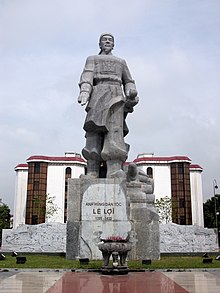Lê Lợi
Lê Lợi (* 1385 ; † 1433 ; temple name Lê Thái Tổ ) was the first monarch of the Lê dynasty and Emperor of Vietnam from 1428 to 1433. He is considered in Vietnam as a champion of the country's independence from the then Chinese Empire .
Origin and early years of life
Le Loi was the offspring of a family of landowners from what is now Thanh Hoa Province . There are contradicting statements about ethnic origin. It is believed that he came from the ethnic group of the Muong or the Trai. He passed the Mandarin exams and entered the service of the Ho Dynasty, which was overthrown in 1407 by the neighboring Chinese Empire under the Ming . After the Ming conquest, Le Loi returned to his hometown and supported the re-establishment of the Tran dynasty. After their proponent Tran Quy Khoang was defeated by the Ming in 1413, Le Loi made his peace with the Ming.
Rebellion against the Ming Dynasty
In 1418 after a dispute with a rival nobleman who continued to accuse him of rebellion, Le Loi settled in the mountains of his home region and began a guerrilla campaign against the rule of the Ming dynasty. The following year he captured his competitor's fortification. In 1422, however, he was defeated by Ming troops and the Lao allies with them . Le Loi was again recognized as a vassal by the Ming in return for payment of compensation in gold .
In 1424 the Ming emperor Yongle died . His successors pursued a policy of consolidating the empire and as a result withdrew their engagement in Vietnam. In the year Jongle died, Le Loi started another military rebellion against the Ming and tried to displace the Ming from the Red River Plain. In 1425, Emperor Xuande formulated the goal of returning Vietnam, which was ruled as a province, to vassal status under the rule of the Tran. After several military victories and the conquest of Dong Kinh , today's Hanoi, Le Loi took over the rule of Vietnam as monarch in 1428. Le Loi based his warfare on Chinese models, including the adoption of their organizational forms and gunpowder weapons .
Monarch and founder of the dynasty
Le Loi proclaimed himself emperor. In the year of his accession to the throne, he introduced his own coinage. In 1429 he demobilized most of an army in order to free labor for agriculture . He continued the policy of the predecessor dynasties and the Ming, who structured the state in Vietnam on the Confucian model. The aim was to organize the villages as self-governing units with enough land allocation per family to generate tax-paying, economically independent farmers. This was at the expense of the aristocratic landowners , as well as the land ownership of Buddhist temples. One of the leaders of his court was the scholar Nguyễn Trãi , who headed the civil administration of the empire and had not collaborated with the Ming.
In diplomatic negotiations, however, Le Loi reestablished a good relationship with the Ming, who recognized him as monarch of Vietnam in 1431. His son and actual heir to the throne, Lê Tư Tề , was excluded from the succession due to his lack of character and after his death demoted to the common. His successor was his son Lê Thái Tông , who was ten years old at the time of his death.
In Vietnamese historiography , Le Loi is considered a pioneer for the country's independence from Chinese rule. Historian Keith Weller Taylor sees Le Lois' political legacy in the formation of a political alliance between the Kinh of the Red River Plain and the non-Kinh peoples of his southern homeland in competition with the rule of the Chinese Empire.
Legends
Le Loi is the subject of numerous popular folk tales in Vietnam. One of them is that by heaven's favor he came into possession of a magical sword to unite Vietnam against the Chinese. After his accession to the throne, he brought the magic sword back to Hoan Kiem Lake and returned it to a turtle -shaped ghost (the "golden turtle" Kim Quy ). The lake is now a landmark in Hanoi.
Individual evidence
- ↑ a b c d e f g K. W. Taylor: A History of the Vietnamese. , Cambridge, 2013 pp. 182-192
- ^ William J. Duiker, Bruce Lockhart: Historical Dictionary of Vietnam , Lanham, 2006, p. 206
- ↑ a b Christopher Goscha: Vietnam - A New History. , New York, 2016, pp. 29–31
| personal data | |
|---|---|
| SURNAME | Lê Lợi |
| ALTERNATIVE NAMES | Le Loi |
| BRIEF DESCRIPTION | Vietnamese emperor, first emperor of the Lễ dynasty |
| DATE OF BIRTH | 1385 |
| DATE OF DEATH | 1433 |

